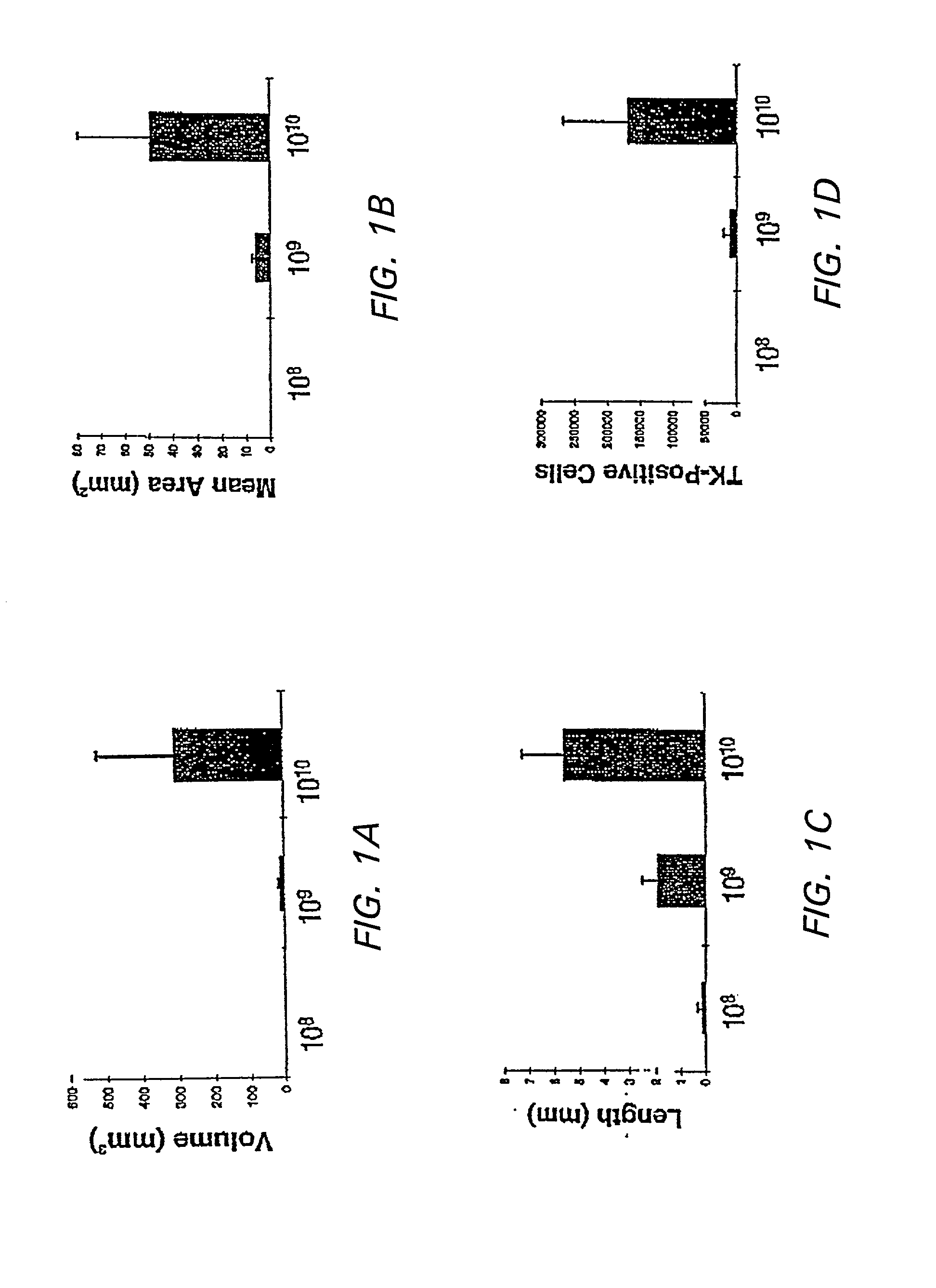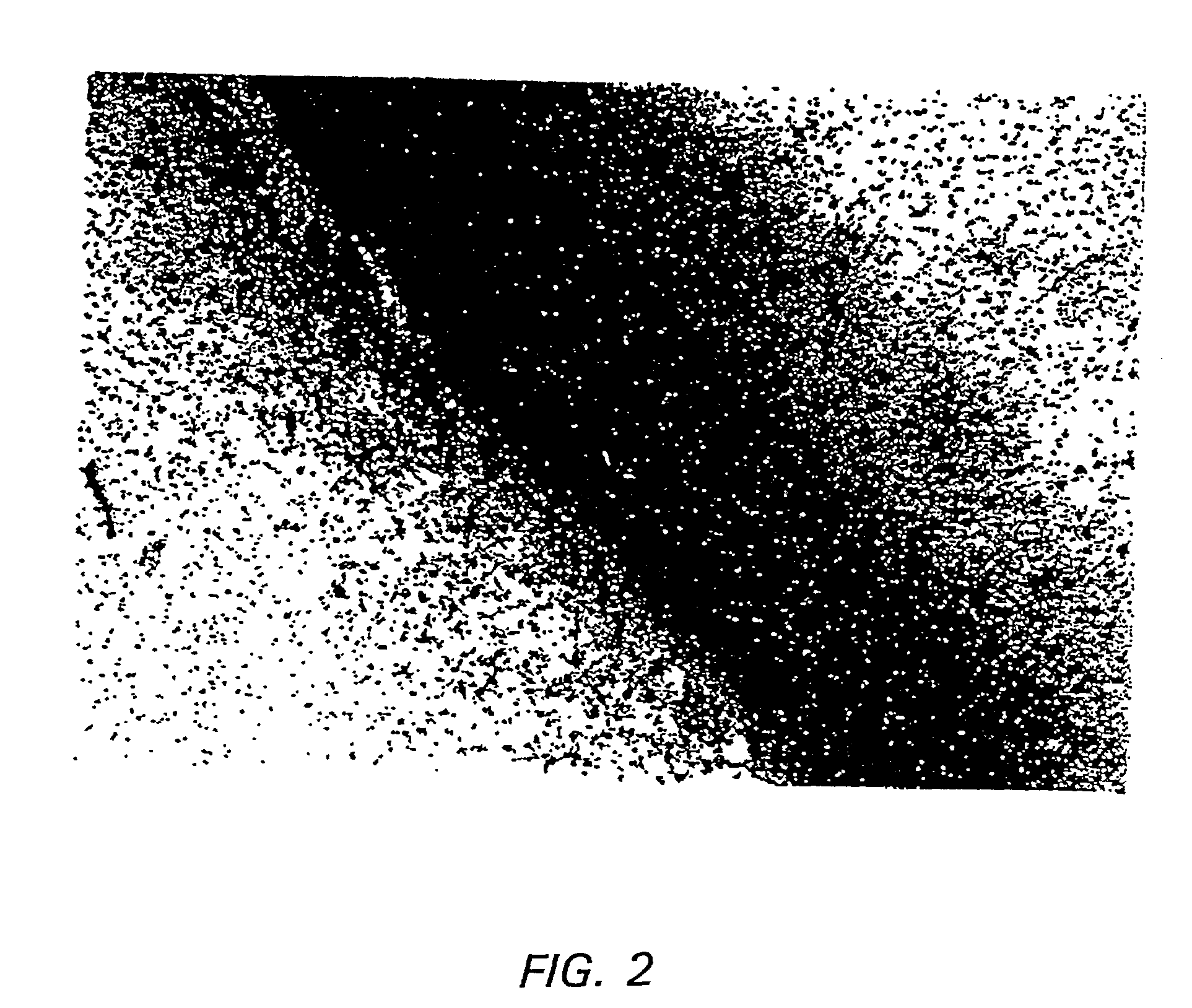Convection-enhanced delivery of AAV vectors
a vector and vector technology, applied in the field of vector delivery, can solve the problem that researchers have had only minimal success in delivering viral vectors to widespread areas of the brain
- Summary
- Abstract
- Description
- Claims
- Application Information
AI Technical Summary
Benefits of technology
Problems solved by technology
Method used
Image
Examples
example 1
[0119] CONSTRUCTION AND PRODUCTION OF AAV-TK
[0120] The AAV-tk vector was constructed by placing the herpes simplex virus thymidine kinase (tk) gene under the transcriptional control of the cytomegalovirus (CMV) immediate early promoter in a pUC-based plasmid (available from, Roche Molecular Biochemicals). A .beta.-globin intron was located directly upstream from the tk gene and human growth hormone poly-A was placed downstream. The entire cassette was flanked by AAV inverted terminal repeats (ITRs) that are required for gene expression, replication, and packaging into viral particles.
[0121] Recombinant AAV virions were produced in human 293 cells (readily available through, e.g., the American Type Culture Collection under Accession Number ATCC CRL1573) as follows. The 293 cell line was cultured in complete DMEM (Biowhittaker) containing 4.5 g / liter glucose, 10% heat-inactivated fetal calf serum (FCS; Hyclone), and 2 mM glutamine. Subconfluent 293 cells were co-transfected by calcium...
example 2
[0123] IN VIVO DELIVERY OF AAV-TK: DOSAGES AND METHODS
[0124] In order to determine the appropriate dose of AAV to introduce into the brain, the following study was conducted. The striatum was used to test dose response to the AAV vector because of its relatively large area of homogenous tissue and because it is a target for treatment of neurodegenerative disease and other central nervous system disorders.
[0125] In addition, efficient methods of delivering vector to the CNS were determined. Simple stereotactic injection of therapeutic agents has been shown to result in limited volume of distribution in brain (Kroll et al, (1996) Neurosurgery 38:746-754). Therefore, slow infusion pumps were used to maintain a pressure gradient during intracranial delivery. Previous studies concerned with the delivery of small, medium, and large molecules to brain have demonstrated that slow infusion pump results in extensive and homogenous tissue distribution.
[0126] To investigate which method of admi...
example 3
[0150] GENE THERAPY OF PARKINSON'S DISEASE
[0151] Convection-enhanced delivery of AAV vectors carrying the transgene encoding AADC was shown to restore dopaminergic systems in MPTP-induced Parkinson's disease in monkeys as follows.
Animals
[0152] Rhesus monkeys (n=4, 3-5 kg) were chosen as candidates for implantation based on the evolution of their parkinsonian symptoms. Animals were lesioned by infusing 2.5-3.5 mg of MPTP-HLC through the right internal carotid artery ( referred to as ipsilateral side) followed by 4 I.V. doses of 0.3 mg / kg of MPTP-HCL (referred to as contralateral side) until a stable, overlesioned hemi-parkinsonian syndrome was achieved (Eberling, (1998) Brain Res. 805:259-262). The primate MPTP model is considered the gold standard model of evaluation prior to human trials. (Langston (1985) Trends Pharmcol. Sci. 6:375-378). MPTP is it converted in the CNS to MPP+ by monoamine oxidase B. MPP+ is a potent neurotoxin which causes degeneration of the nigral dopaminergic ...
PUM
| Property | Measurement | Unit |
|---|---|---|
| Therapeutic | aaaaa | aaaaa |
Abstract
Description
Claims
Application Information
 Login to View More
Login to View More - R&D
- Intellectual Property
- Life Sciences
- Materials
- Tech Scout
- Unparalleled Data Quality
- Higher Quality Content
- 60% Fewer Hallucinations
Browse by: Latest US Patents, China's latest patents, Technical Efficacy Thesaurus, Application Domain, Technology Topic, Popular Technical Reports.
© 2025 PatSnap. All rights reserved.Legal|Privacy policy|Modern Slavery Act Transparency Statement|Sitemap|About US| Contact US: help@patsnap.com



